BEASTS OF THE ‘BHAN
In the 1980s, battles raged between Germany’s chief power brokers to try to win the war of the autobahn. How did they compare then, and which is the best modern classic today?
Mercedes-Benz 560SEC vs BMW M635CSi vs Porsche 928 s4
Let’s start by thanking West German road transport policy in the 1970s and ’80s, which did more than anything else to shape the cars we’re celebrating.
That’s because, while the first autobahns had been constructed before World War II, it was only as the capitalist part of the country became increasingly prosperous in the ’60s that the network expanded. In 1970, there were 2500 miles of autobahn; by 1980, that had risen to 4530, and by 1990 – when Germany was reunited – there were 5500 miles. And what were the increasingly rich and hurried Germans going to drive on this splendid, and mostly derestricted motorway network? Cars like these, of course.
By the mid-1970s, the top German manufacturers found themselves in the middle of an almighty power battle, trying to create the ultimate high-speed coupés. Faster and more affordable than the hand-built Italian GTs from Lamborghini, Maserati and Ferrari that dominated this market sector, these cars were designed to operate safely at the sort of speeds that would have shaken their bespoke supercar rivals to pieces.
Although built for German tastes, they became hugely popular here in the UK, too. OK, so you’d have been arrested for travelling at 150mph on a British motorway – when (or if) the wheezing police Granada or SD1 caught up with you – but wealthy buyers could still enjoy the comfort and prestige that came from owning an autobahn-stormer. These bruisers from Porsche, BMW and Mercedes-Benz all gave you the opportunity to flaunt your wealth as the country powered through the ’80s – and consumption didn’t get much more conspicuous than a gold Mercedes SEC.
They make a strong case for themselves today, and there are still decent numbers of 928s, 6-series and SECs out there to choose from. There is also a large number of specialists to help keep them in tip-top condition.
All these models are far easier to work on than the electronics-laden vehicles that replaced them in the 1990s-’00s. And although keeping one in prime condition isn’t going to be cheap, good ones seem to have long since stopped losing value and are now actually rising.
Even by modern standards each is still properly fast – three decades ago they must have felt like rocketships. Despite similar power outputs and north-of-150mph top speeds, there’s no chance of confusing any of our challengers. In terms of both looks and dynamic character, the BMW M635i CSi, Porsche 928 S4 and Mercedes-Benz 560SEC are very different animals.
Solid and four-square on the road, impressively stable and surprisingly soft. It’s very much the old man of the group
Mercedes-Benz 560SEC
The sodden conditions in our test location at Dunsfold, during the height of an almighty thunderstorm, also serve a purpose beyond making the photographs look dark and moody – they emphasise the broadness of the talents of our threesome. None of them leaks, steams up or becomes skittish when asked to deal with standing water – all are still eminently usable every day.
The bright gold Mercedes-Benz 560SEC initially steals the show – it’s big, imposing, and very stylish. It also has quite a history, which might explain why it’s now part of Mercedes-Benz UK’s heritage fleet. Past owners include art critic Brian Sewell and, before him, Nigel Mansell.
Given its looming and unsporting presence, your expectations are that it’s going to be a less engaging drive than the Porsche 928 or BMW M635CSi. As the coupé version of the W126 S-class saloon, its mission was to deliver the same level of security and waft, only with fewer doors, much neater styling and an added dose of exclusivity.
Initially your expectations are met –imagine driving a very comfortable sofa that can throw you effortlessly towards the horizon, and you have some idea of how the mighty Mercedes-Benz goes down the road.
It’s a cruiser not a bruiser, and back in 1989 its biggest rival was a company Learjet
Everything about it seems designed to make life as easy as possible, from electrically adjustable seats through to the deferential way the standard automatic gearbox shuffles its ratios. The 5.5-litre engine came only three years after the launch of the original C126 coupé, and as well as a power and torque boost over the earlier 500 SEC, it had a standard limited-slip differential to help it deliver its 295bhp and 317lb ft of torque safely to the road surface.
Although you can hustle the 560SEC along at quite a pace if the mood takes you, it’s a cruiser rather than a bruiser. It has finger-light power steering, generously boosted brakes and a cabin that’s calm even at autobahn cruising speeds. Back in 1989 it’s biggest rival was probably a Learjet.
But should you feel suitably naughty, the SEC has a party trick up its sleeve. Select Sport mode on the floor-mounted gear shifter and it’ll accelerate like a rocket. There’s almost no hesitation as it hurls forward in a manner more sudden than you expect. It’s a full-on, deeply addictive kick. Just try to avoid worrying about fuel consumption, which will soon drop to less than 10mpg if you really start pushing.
The range-topping C126 coupé was a technical tour de force in its day, pioneering many systems that have become ubiquitous in more mainstream cars since it was launched.
It was the first European car to be offered with a driver’s airbag. Anti-lock brakes were standard, too, and traction control was an option on later cars. It also introduced features such as automatic climate control and puddle lighting when you open the doors.
This particular SEC is fully loaded, presumably at Our Nige’s insistence, and everything still works. It feels like a liberally-stocked toyshop compared with the BMW or Porsche. For us, though, the highlight of the SEC experience has to be the automatic seatbelt winder – you’ll never get tired of surprising first-time passengers with a robot arm that politely offers them their belt.
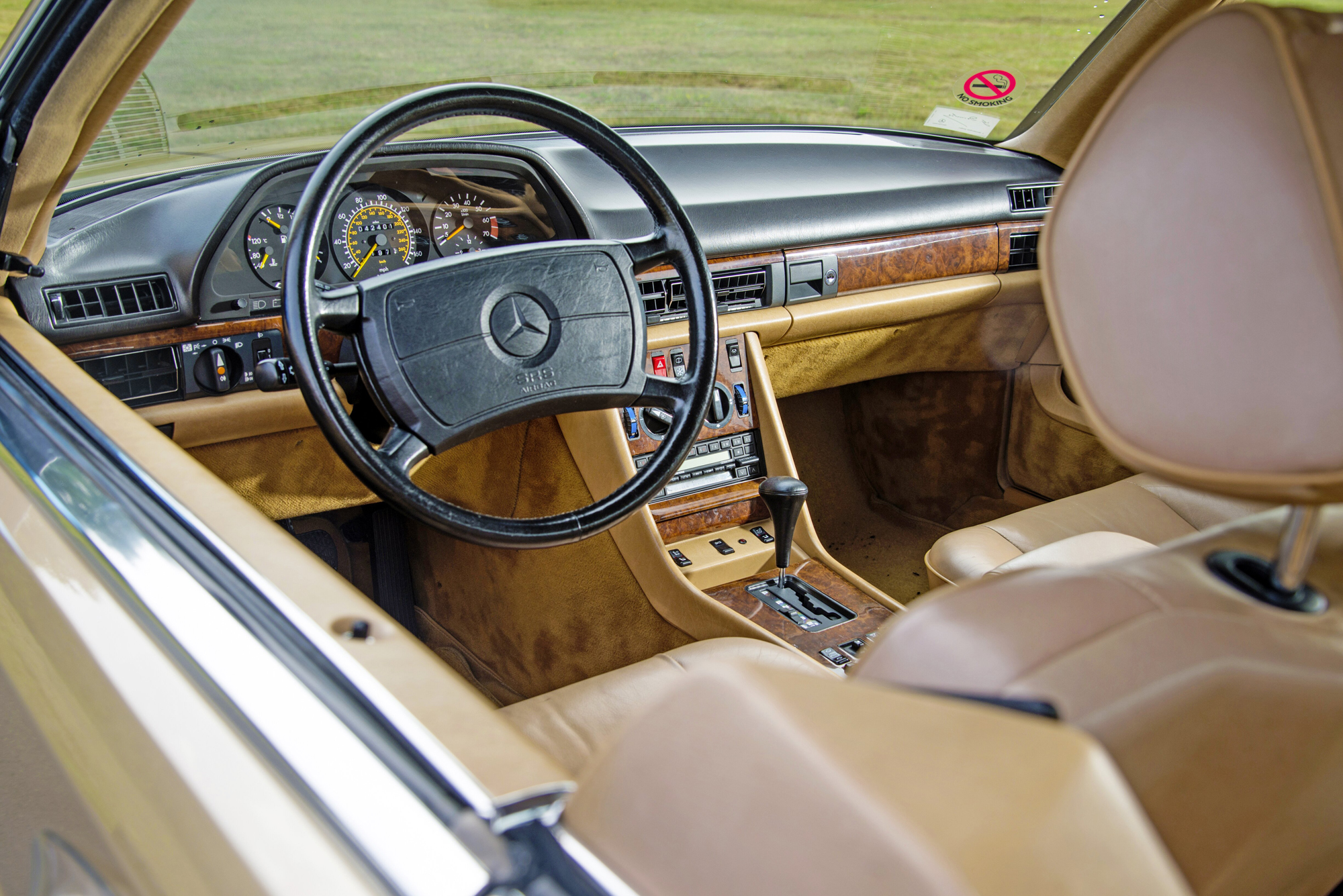
Buying Mercedes-Benz 560SEC
There are plenty of cautionary tales of people who have bought W126 S-classes and their C126 cousins on the basis of their mechanical strength, expecting them to be as dependable as a more modern car, only to uncover a host of costly problems when they’re being used. As with any prestige car, long-term happiness comes with the knowledge that it’s been properly maintained.
Rather like the BMW 6-series also covered in this group, the biggest problem with Mercedes-Benz C126s that have spent their lives in the UK is likely to be the rust, which can strike in the bodywork or the deeper structure. Always check thoroughly underneath – extensive bulkhead repairs, particularly, can very effectively write off a car.
Mercedes-Benz’s M117 V8 engine in 5.5-litre form is reckoned to be bombproof providing it has been looked after, with timely oil changes and scrupulous servicing. The four-speed automatic transmission is strong, but make sure you look for evidence of regular fluid changes – they really do prolong gearbox life.
The 560SEC has self-levelling rear suspension, which will cost more than £1000 to put right if it starts to sag. Electric windows and the vacuum-operated central locking system can fail and are a nightmare to diagnose and, ultimately, resolve.
Despite values still being in the doldrums, relatively speaking, there are a reasonable number out there with a low mileage and full history, so you can afford to be picky. The 560SEC is a true modern classic, in that it’s now on the appreciation curve, with long-term value growth looking promising as poor examples disappear.
With a new 295bhp 5.5-litre engine introduced in 1985, the SEC was clearly in the running for the title of the best coupé that money could buy
SPECIFICATIONS
Engine 5547cc/V8 cyl/OHC Power 295bhp@5000rpm Torque 335lb ft@3750rpm Maximum speed 155mph 0-60mph 6.8sec Fuel consumption 14-20mpg Buying info headline Transmission RWD, four-spd auto How many left? 370 Cost new £56,250 Value now £15,000
It looks about as 1980s as it’s possible to get without clutching a Filofax in each hand
BMW M635CSi
The BMW M635iCSi is one of the very rare UK-only Motorsport editions, meaning it was loaded with every available option. It’s seen action, too – there are 129,000 miles on the odometer – but it also has a history file that suggests it’s been extremely well cared for.
In contrast to the Mercedes-Benz and Porsche’s timeless lines, the M635CSi looks about as ’80s as it’s possible to get without wearing a shoulder-padded jacket and clutching a Filofax in each hand.
The E24 6-series was an extremely long-lived car, on sale from 1976 to ’89, but the ultra-clean lines of the early versions were lost beneath some very muscular bodykit cladding as time went on. Compared with the 928, it looks very tall and upright, but in the cabin the large glasshouse provides excellent visibility. By the standards of the day it was a tech-laden car, with a multi-function trip computer (bearing a strong resemblance to an early Sinclair calculator) and – on this car – even a period British Telecom carphone that the first owner presumably used to seal deals from the fast lane of the M1. The straight-six fires into life with a purposeful snarl that leaves little doubt of the M635i’s motorsport pedigree – its engine is very closely related to the one that powered the BMW M1 supercar.
Rolled out at the end of 1983, this was the ultimate 6-series. Powered by the M1’s 286bhp straight-six, it was good for 160mph and 0-60 in 6.4 seconds
The straight-six can’t match the grunt of the Porsche’s V8, although 282bhp was a remarkable output for a 3.5-litre of the period. It’s far keener to rev, pulling enthusiastically and delivering a forceful shove that certainly doesn’t feel three decades old: a 6.3-second 0-60mph time made it faster than anything but the most exotic supercars when it was new. The five-speed manual gearbox on this one doesn’t feel as sharp as we suspect it should – new linkage bushes would probably tighten it up – and the clutch pedal is heavy.
However, it steers and changes direction with markedly more enthusiasm than the Mercedes-Benz. The rack isn’t ultra-accurate, but it delivers strong front-end responses alongside excellent feedback, with the rear tyres happy to play along to the throttle pedal. Even in the wet it feels progressive rather than snappy – alive and always exciting.
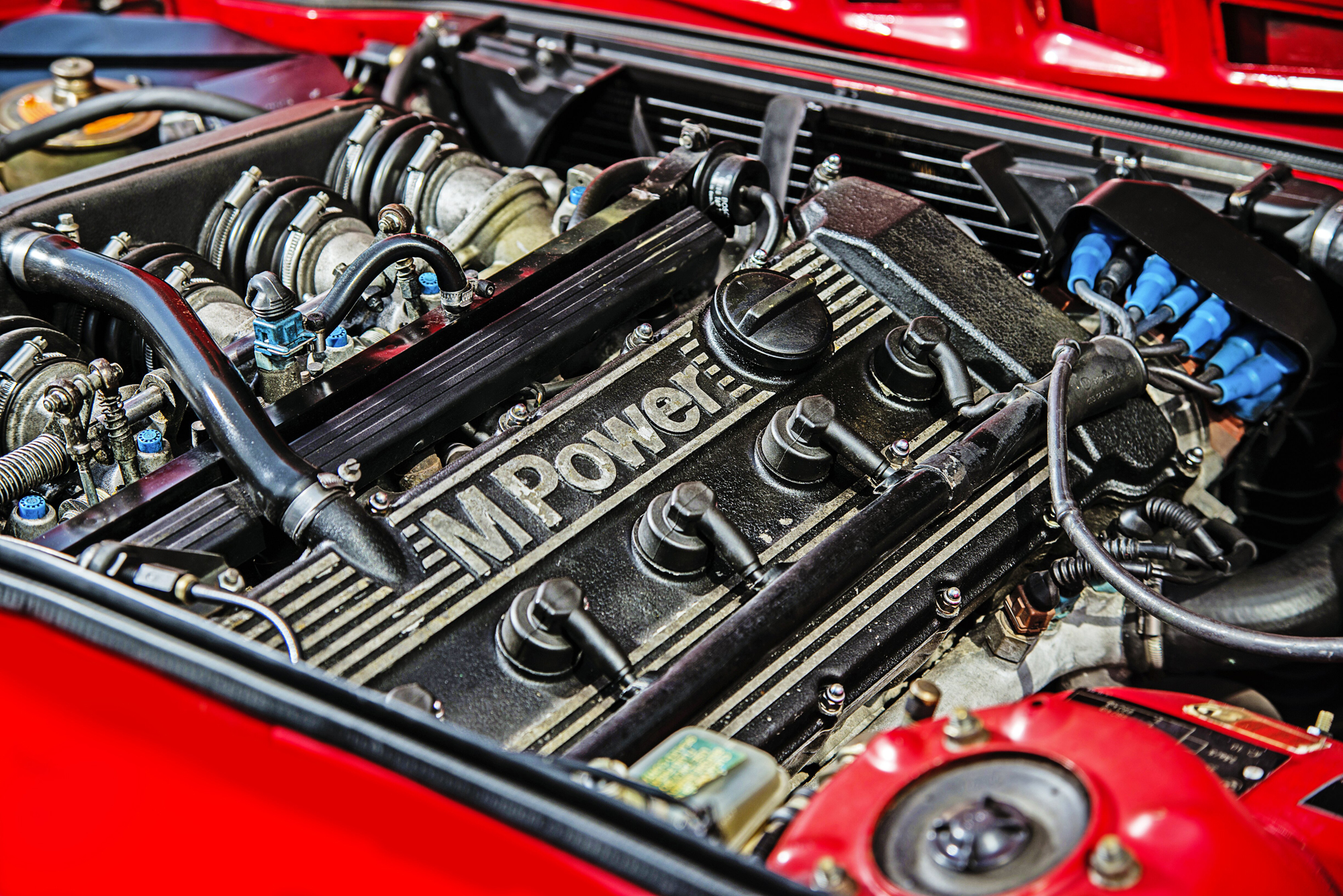
Straight-six M88/3 engine is the stuff of legends, and delivers 282bhp with a wonderful shriek you’ll adore
Buying a BMW M635CSi
The E24’s 1970s origins mean that, like most cars from the period, they are susceptible to rust – but no more, no less than any rival. The good news is the worst ones have long since disappeared or became donor cars, leaving a fine stock of high-quality specimens.
Rear window mechanisms fail due to rust, and all jacking points are vulnerable to corrosion. Rust on the tilt/slide sunroof can be hidden on the inside of the mechanism, so do look closely, especially on cars that are not regularly garaged.
Slack front windows are not uncommon on this model, and this is usually down to the regulators wearing out over time. It’s a fiddly DIY repair, rather than a costly one, so you should also budget for rage- induced teacup replacement.
Original interior trim parts are expensive and increasingly hard to find, so make sure that it’s complete.
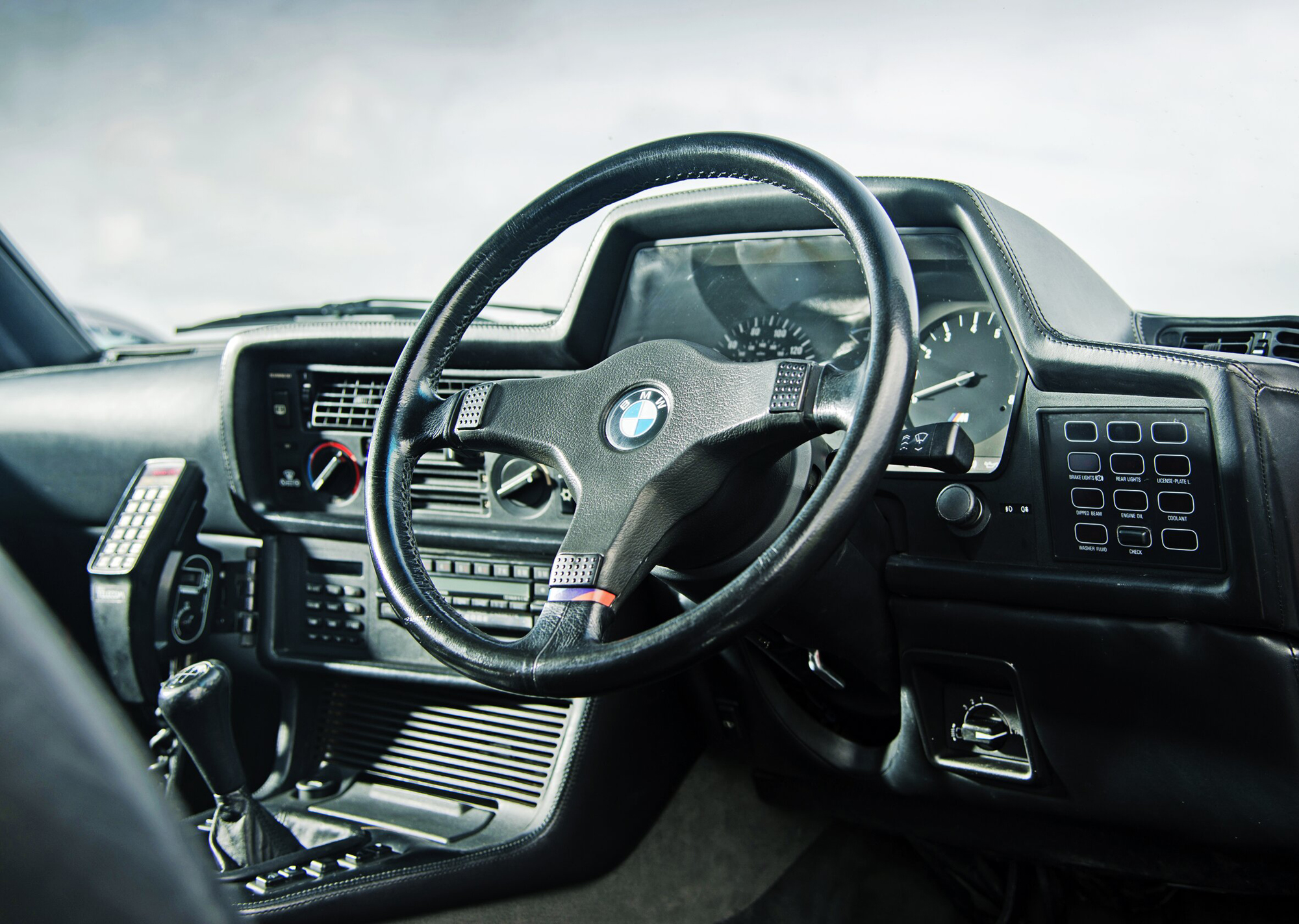
The engine is generally strong and uses a timing chain, which will usually start to make a noise if it needs to be replaced or the guides are wearing out. Don’t ignore it!
Electrical faults are often caused by poor connections or ageing aftermarket alarms. Make sure the ABS light comes on and goes off when the engine is started – a common ‘fix’ is to remove the bulb.
BMW 6-series values are already on the rise as numbers of poor examples fall, but the M635CSi is already showing marked growth. The best examples are now worth 30% more than in 2012.
Your content goes here. Edit or remove this text inline or in the module Content settings. You can also style every aspect of this content in the module Design settings and even apply custom CSS to this text in the module Advanced settings.
Specifications
Engine 3453cc/6-cyl/DOHC Torque 251lb ft@4500rpm Power 282bhp@6500rpm Maximum speed 158mph 0-60mph 6.3sec Fuel consumption 18-28mpg Transmission RWD, five-spd man How many left? 230 Cost new £32,195 Value now £17,000
It may be a 320bhp rear-wheel drive hot-rod, but you’ll feel in full control at all times, even in a British ‘summer’
Porsche 928 S4
This 928 is a 1991 S4 model, meaning it’s powered by the later 32-valve 5.0-litre V8 mounted beneath the long bonnet that pumps out 316bhp. Like most 928s this sends drive rearwards via a four-speed Mercedes-Benz sourced automatic gearbox in place of the standard five-speed transaxle. It’s also covered just 37,500 miles from new.
In comparison with the oh-so-1980s 560SEC, the sleek lines of the 928 still look modern from almost every angle – remarkable when you consider it first appeared in 1977. Small wonder the 928 is cited as an inspiration by so many car designers. Peter Horbury, for example, has admitted that the rear windows he penned for the Ford Sierra XR4i were his own homage to it.
The metallic purple paint of the car you see here, loaned by Fast Classics in Bramley, works particularly well in the gloomy weather conditions; the similarly vivid hue of the interior trim slightly less so, although you’d probably get used to it over time. The cabin is a comfortable place to spend serious time, with pliant seats, clear instrumentation and none of the cluttered ergonomics of contemporary 911s. There’s an Audi-like slickness to the 928.
The buttons and fixtures have a chunky feel; they’re more like the instruments you expect to find in the futuristic movie cars that feature in sci-fi classics like Blade Runner.
The 928 has a sonorous enthusiasm for exploring the top half of its rev counter
Settle down into the interior and you’re fully laid back – it’s more a capsule to the horizon than a car cockpit.
The 928 had originally been designed to replace the 911, but in truth it was a far different beast than its air-cooled sister: bigger and feeling heavier, it was much more of a GT than the 911 – Turbo models aside – could ever claim to be. CAR magazine’s LJK Setright regarded it as one of the best cars in the world, and it remains the only sports car to have won the European Car of the Year prize.
The big V8 is still the 928’s defining feature, with an abundance of torque giving it solid urge pretty much regardless of engine speed. But it’s more than just a low-down slugger, with a sonorous enthusiasm for exploring the top half of its rev counter when called upon to do so — it’s definitely the quickest in the group. It sounds great as well, like a big, comfortable CanAm racer.
But the gaps between the ratios of the autobox make themselves felt. Only 15% of later 928s were specified with the five-speed manual transaxle, but they’re definitely worth looking out for. However, with some London dealers asking for more than £50,000 for low-mileage manual examples, you’ll need to look hard and wide to land one of these for a reasonable price.
Your first introduction to the 928’s steering may be disappointing – at low speeds it’s heavy to the point of being obstinate. But that’s a false impression – get on to sweeping A-roads, increase your pace, and it all starts to click. Pushing on and strong-arming the 928 through long sweepers with forceful but smooth steering inputs is the way to handle it, revelling in the linear responses and the vast reserves of grip.
Then when you come to a straight, boot the throttle and relish that V8 roar. Even with an automatic gearbox, you’ll feel properly involved, with instant throttle response, and a V8 soundtrack unleashed straight from Beelzebub’s basement. This is not a car for the faint of heart or small of bicep – and it’s all the better for it.
However, it steers and changes direction with markedly more enthusiasm than the Mercedes-Benz. The rack isn’t ultra-accurate, but it delivers strong front-end responses alongside excellent feedback, with the rear tyres happy to play along to the throttle pedal. Even in the wet it feels progressive rather than snappy – alive and always exciting.
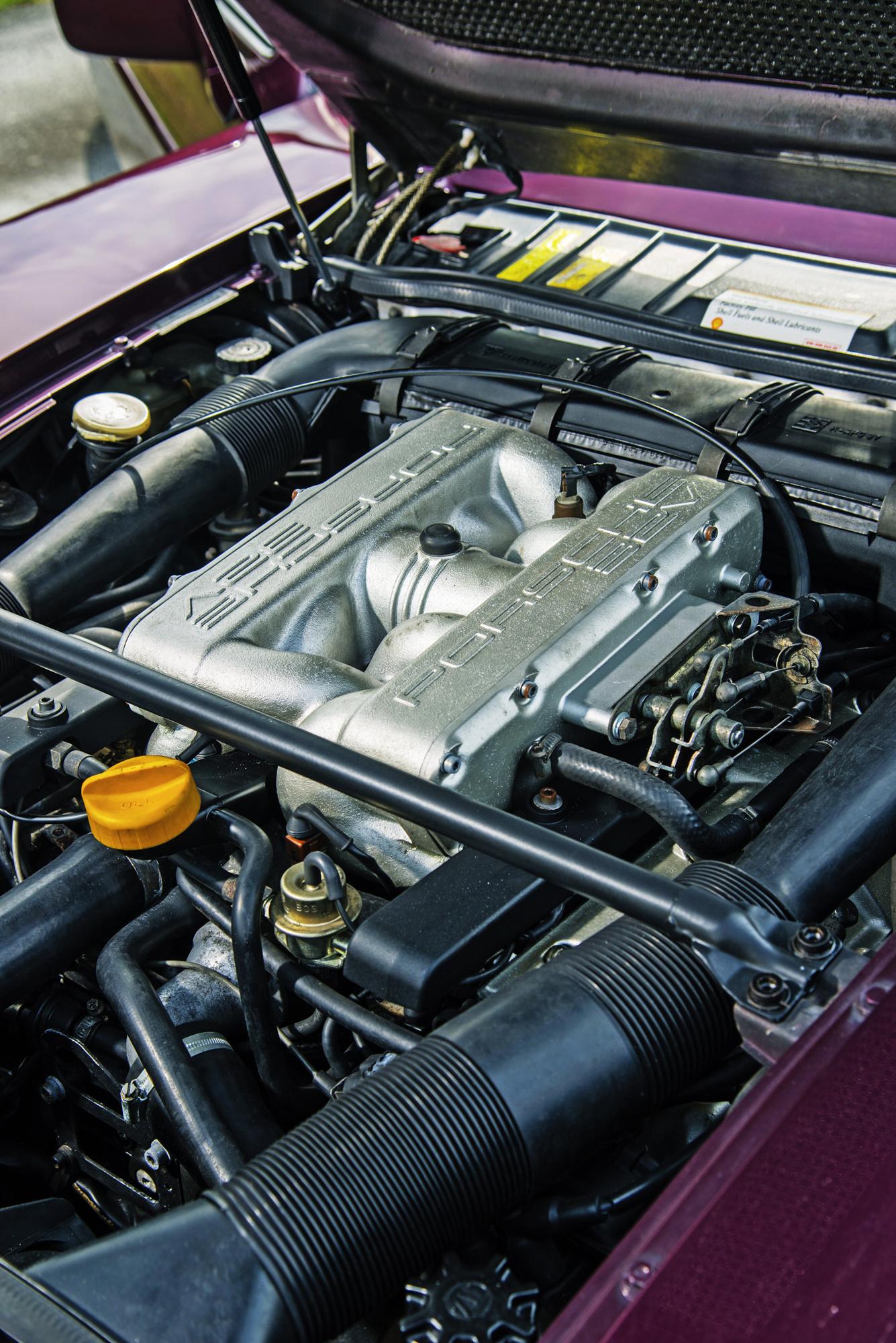
Launched in 1986, the S4 upped the ante for Porsche thanks to new four-valve heads for its V8. This pumped up power to 320bhp, for a top speed of 170mph
BUYING PORSCHE 928 S4
The 928 has a reputation for wallet-wilting meltdowns, yet it’s also fair to say that this is only half-deserved. It’s biggest problem for many years was caused by its low values – it was the Porsche that many people could afford to buy, but not really to run.
The good news is that corrosion is rarely an issue, thanks to the combination of a galvanised bodyshell (on all models and not just the late-model S4) and the extensive use of aluminium panels. Interior build quality is not on a par with the famously solid 911, so check nothing’s broken inside. Be aware that many have been fitted with in-car phones, so check the dashboard leather is at least tidy if not quite how it left Stuttgart.
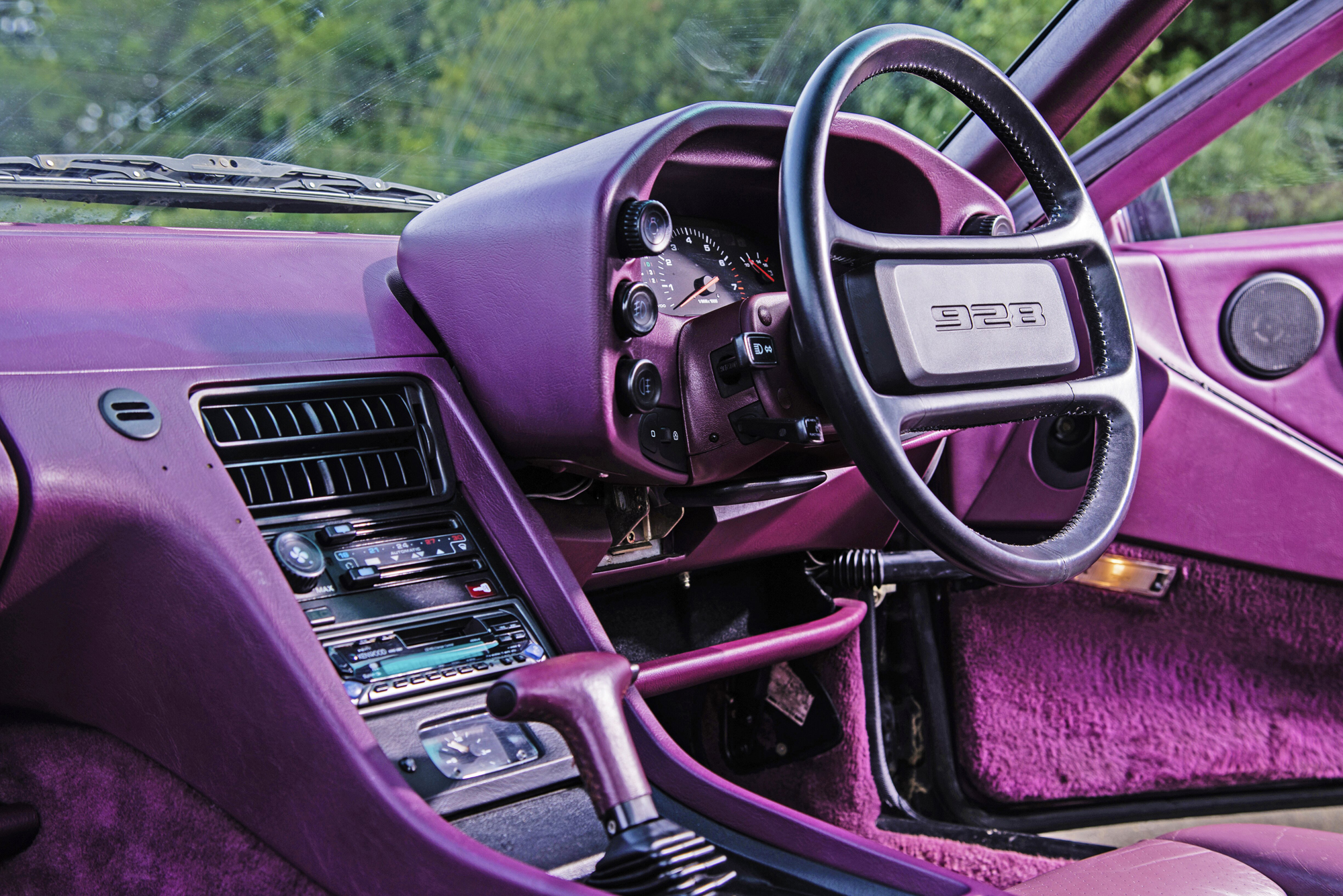
Mechanical complexity means there’s lots to potentially cause big expense, with the largest worry being timing belt failure (the belt is more than 2m long on the 32-valve engine). It should be replaced every four years or 45,000 miles (at a cost of around £600 at a specialist), with a fresh water pump installed at the same time. Linerless cylinder bores are also a concern – cars need to have had regular coolant changes.
Worn suspension can result in noises or inaccurate steering, but the biggest problems are often electrical ones, with some connectors and joints failing and producing hard-to-trace symptoms. Aftermarket alarms/immobilisers can drain batteries.
Gearboxes are tough – the automatic is from Mercedes-Benz, and will go on forever if the fluid is changed regularly, while manual transaxles don’t present any problems.
SPECIFICATIONS
Engine 4957cc/V8 cyl/DOHC Power 316bhp@6000rpm Torque 317lb ft@3000rpm 0-60mph 5.7sec Maximum speed 170+mph Fuel consumption 10-20mpg Transmission RWD, four-spd auto How many left? 633 Cost new £46,534 Value now £20,000
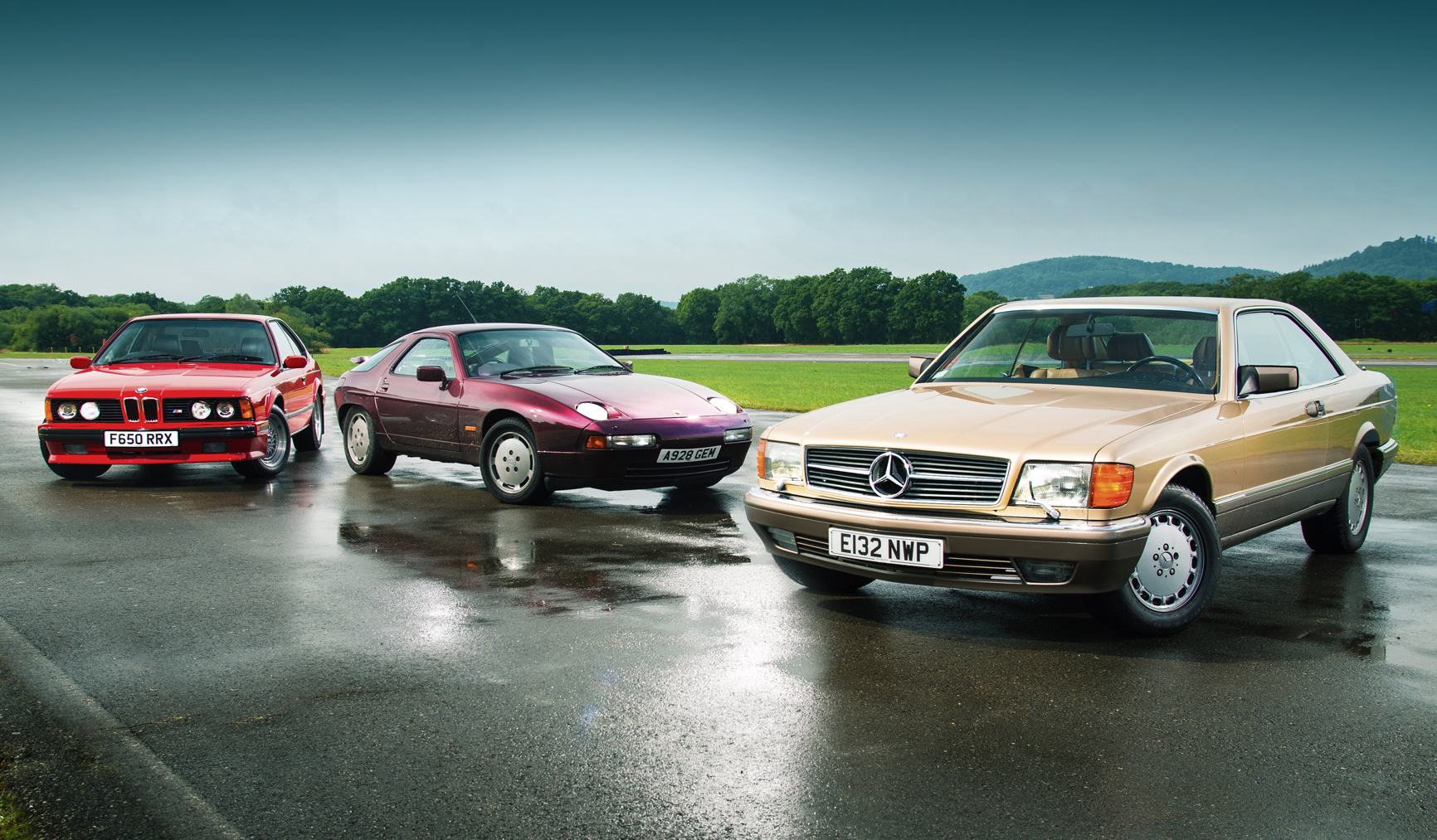
THE LAST WORD
This is one of those tests that makes you really wish for a time machine. It would be magical to experience any of these cars when they were new and so much faster and more powerful than almost anything else on the road.
All three still feel properly rapid today, which is testament to just how far ahead of the curve they were.
The Porsche is definitely the design icon in this pack, but it’s also curiously hard to warm to. Porsche was determined to make it more sensible and usable than the 911, which arguably pushed it slightly too far in the other direction. It’s a tool for going very, very quickly, but it’s a bit devoid of soul in this company – unless you’re truly hammering it, that is.
The M635CSi feels like a car that’s on the cusp of greatness. Usable and enormous fun to drive, it deserves to be treated like the true ‘M’ car it is, and there’s the sense that it’s been overlooked for too long. It may present some ownership hassles that may cause you to think twice about using it in anything but perfect weather, but its soul-tingling six-cylinder buzzsaw will change that.
Yet the SEC is a compelling and multi-talented offering, too, especially now values are rising.
As modern classics, they all have appeal. The 928 S4 is rowdy and brimming with attitude, while the M635CSi’s dynamic excellence makes it most special. But the SEC is the prime modern classic by a narrow margin – it’s simply more driveable for more of the time. That it’s now beginning to appreciate strongly is the icing on the cake.
Thanks to 4Star Classics for the BMW M635CSi (4starclassics.com), Fast Classics, for the Porsche 928 S4 (fast-classics.com) and Mercedes-Benz World (mercedes-benzbrooklands.co.uk).
